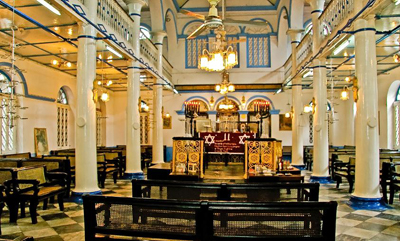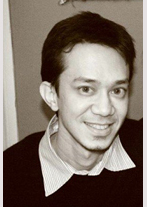 Interior of Musmeah Yeshua
Interior of Musmeah Yeshua
________________________________________________
By Sammy Samuels

 YANGON, Myanmar–Jewish life in Burma today is quite different from what it was during colonial times, which lasted until World War II. Before the war, it still was the case that “the sun never set” on the British Empire, including in Southeast Asia. Jewish merchants, who migrated originally to Burma in the late 1800’s, served as a natural conduit between the British colonial rulers and the export–import community abroad. The Jewish community of approximately 2,500 people was a respected presence in business and a valued part of local society. During this “Golden Age” Jewish influence within the government and society as a whole grew rapidly.
YANGON, Myanmar–Jewish life in Burma today is quite different from what it was during colonial times, which lasted until World War II. Before the war, it still was the case that “the sun never set” on the British Empire, including in Southeast Asia. Jewish merchants, who migrated originally to Burma in the late 1800’s, served as a natural conduit between the British colonial rulers and the export–import community abroad. The Jewish community of approximately 2,500 people was a respected presence in business and a valued part of local society. During this “Golden Age” Jewish influence within the government and society as a whole grew rapidly.
Jews were incorporated into the life of the country and played a prominent part in various fields. In tropical Rangoon Jews owned ice factories and bottling plants. Some dealt in textiles and timber, while others were customs officials and traders. Jews held a designated seat on the Rangoon Municipal Committee. The Jewish community in Burma was so influential, in fact, that in the first years of the century, Rangoon and the smaller city of Bassein had Jewish mayors, and Judah Ezekiel Street in downtown Rangoon was named to honor a Jew. The Sofaer family donated the iron gates to the Rangoon Zoo, and another Jew, Mordechai Isaac Cohen, donated the beautiful cast-iron bandstand in Bandoola Square. Both are still standing tall today.
In the center of downtown Rangoon (now Yangon) stood Musmeah Yeshua, the grand synagogue with its soaring ceiling and graceful columns. Musmeah Yeshua, one of 188 sites on the list of Yangon Heritage Buildings, was constructed in the 1890s. The Jewish cemetery, with more than 600 gravestones, and the synagogue with its 126 silver sifrei Torah (Torah scrolls) and Jewish school for over 200 students, proclaimed Jewish affluence and comfort in this lush land.
As Jewish wealth grew in those early days, Jewish philanthropy grew as well. The community donated large sums for local schools, libraries, and hospitals and helped local Burmese in many different ways. The Burmese were very appreciative of this aid and the country was a welcome and tolerant home for Jews for many years.
The golden days of Jewish life in Burma came to a close when the Japanese invaded in 1941. Japanese occupation forced most of the Jewish community, along with most of the British colonial population, to flee to other countries. Some Jews returned after the war, but they soon realized that the beautiful life they remembered was no more and their homes and wealth were gone.
Even so, there were promising relations between postwar Burma and the new State of Israel. Burma and Israel both achieved their independence in 1948 and Burma recognized the State of Israel in 1949; it was the first Asian country to do so. Burmese Prime Minister U Nu was the first foreign head of state to visit the newly independent State of Israelin 1955. Six years later, Israeli Prime Minister David Ben Gurion spent two weeks in Burma. President Yitzhak Ben-Zvi, Golda Meir, Moshe Dayan, and Shimon Peres also visited Burma.
Despite these cordial relations, Jews found it difficult to regain their lives and re-establish their businesses in Burma after World War II. The Jews of Burma scattered to Israel, Australia, England, and the United States. Since then, the Burmese Jewish community has continued to decrease in population.
Today, only a handful of Jews live in Burma. For more than 35 years, my family has taken care of the synagogue, cemetery, and what remains of the community. Burma and the Jewish community has always been our home since the 1890s or perhaps even earlier when my great-grandparents left Baghdad to start a new life in the vibrant city of Rangoon. During World War II, my grandfather, Isaac Samuels, risked his life for the synagogue; today, we still revere the same building and its history, which encompasses Jewish life in Burma.
Every day, my father Moses Samuels sits in the quiet synagogue of which he is a trustee, waiting to greet Jewish visitors and to share with them the rich and unique history of the Jewish community of Burma. In particular, every Friday, he and I wait at the synagogue for Jewish visitors hoping we will be able to gather the minyan (requisite ten people) to begin services.
My father has posted a sign on the front door of the synagogue: “A tree may be alone in the field; a man alone in the world, but a Jew is never alone on his Holy Days.” It is my father’s belief that no Jew should be alone during the holidays—and yet most of the time, only the two of us can be found in the synagogue. Even if only we two are present, I always feel the echoes of the many Shabbat services that took place in this beautiful synagogue and I hear the melodies of the songs our ancestors sang when the community was at its peak.
We may not be able to return to the glorious days of Jewish life in Burma, but the community believes that, through tourism, we will be able to make a difference in keeping the Jewish spirit alive here. In 2005, we started the travel agency Myanmar Shalom, with the goal of linking Jews around the world to our small community and enabling visitors to explore and experience this beautiful country about which Rudyard Kipling wrote: “This is Burma and it will be quite unlike any land you know.”
Through years of isolation, the country has managed to retain many of its cultural traditions and to preserve much of its historical heritage—making it one of the few remaining places on earth that truly can bring a visitor back in time to experience the Asia of old. Whatever the politics of visiting Burma, tourists will find a nation of gentle folk and smiling people, rich archaeological sites, glittering pagodas, colorful bazaars, and joyous festivals.
Among many other programs, Myanmar Shalom hosted its unique “Southeast Asia through Jewish Eyes.” Cooperating with Lotus Travels we attracted more than 30 participants led by Rabbi Marvin Tokayer, creator of “Journeys through Jewish Eyes,” and one of the world’s foremost authorities on the Asian Jewish experience.
For many years, the synagogue has not had a local minyan, so the group visit made a difference to this small community—once again filling the Rangoon synagogue with joy and song.
I often think about the “golden days” before World War II, when the synagogue was filled with more than 300 people for all congregational activities — the Jewish holy days, the weddings and bar mitzvah ceremonies. No matter where the descendants of Jews from Burma now live, the synagogue Musmeah Yeshua always will remain an important landmark of Jewish history in Southeast Asia for all of us and a reminder of the very vibrant and lively community that once lived in Burma.
Today, only a few of us are left in Burma, but our Jewish spirit is still alive and our prayer services still continue. I hope that through tourism the Jewish community may begin to revive and that our beautiful synagogue once again will be filled with joy and song as we continue our historic role in the life and welfare of the country.
For more information about the Jewish Community of Burma consult Almost Englishmen: Baghdadi Jews in British Burma by Dr. Ruth Fredman Cernea or contact us at www.myanmarshalom.com.